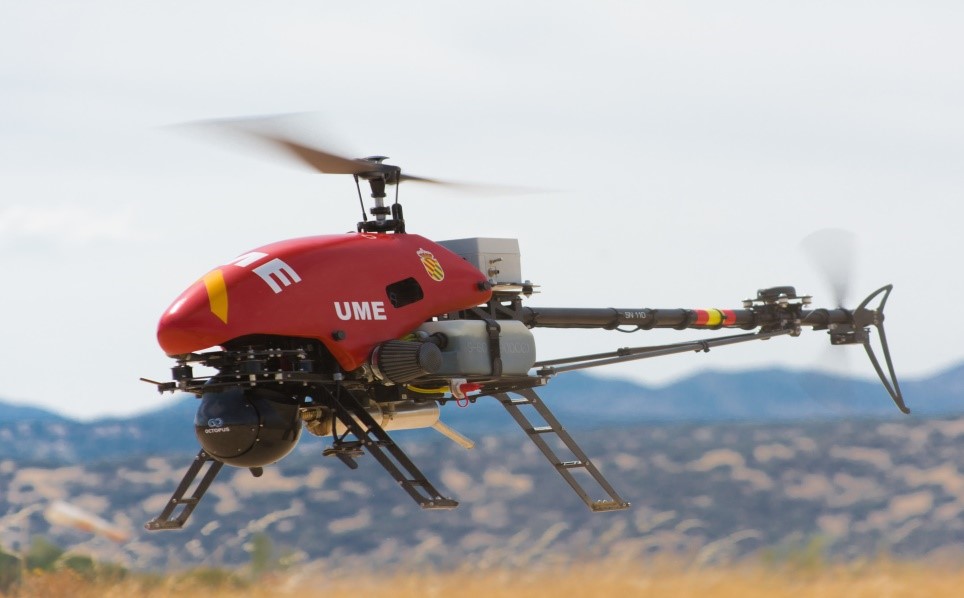Use of rotary wing UAVs can significantly enhance the real-time relay of critical information for first responders
November 4, 2019
By Diego Plaza
When it comes to natural disaster management, and the need to provide fast and effective support to first responders tasked with saving lives and curbing the potential damage to the environment, UAVs (Unmanned Aerial Vehicles), have a clear edge over other, existing platforms.
UAVs in general, and particularly rotary wing UAVs, are fast becoming the leading tool for first responders, especially in disaster scenarios where limited information and chaos are the key characteristics.
Rapid and accurate information collection
At the onset of a fire, flood or other natural disaster, the situation facing first responders is usually defined by many unknowns, often as a result of a lack of line of sight and the resulting block of communications; thus, it is extremely difficult to plan or provide a relevant response. It is for this reason that data collection is so vital during the early stages of a natural disaster, as time is of the essence when saving lives, which is the evident priority for emergency response teams.
This is where UAVs ‘step in big time’, as they are a highly effective and valuable, initial means of communication, capable of providing minute by minute status reports and resulting analysis. Systems like ResponDrone, with several unmanned drones working at the same time, will rapidly become the ‘eyes and ears’ on the ground: amassing information about possible access routes, victims’ locations, providing precision mapping to designate evacuation and supply routes, take-off and landing areas; thus, facilitating faster and easier on-scene arrival capabilities.
Situation control and team safety
In a catastrophe, situation control is vital, and to that end it is necessary to ensure that all available information is constantly updated. This provides the emergency response teams with the ability to make decisions in real time and possibly attempt to anticipate potential, emerging developments.
Furthermore, the use of UAVs, as ResponDrone will demonstrate, allows the teams to operate from a safe position, at whatever time of day or night. The creation of a safe working position, at the operations command centre, also gives the UAV pilots the chance to provide their first hand, professional experience and advice about the data collected to the decision makers face to face.
Rotary wing UAV systems’ distinct advantages
Rotary wing UAV platforms, such as the Alpha 800 UAV used in the ResponDrone project, provide additional advantages in these chaotic situations:
The Alpha 800 platform flies at low speed and low altitude, providing first responders with the capacity to collect more detailed information about what is happening on the ground in the disaster areas.

Its VTOL (vertical take-off and landing) capability within only a 9 m2 area, combined with its maritime capacity and ability to fly within an ambient temperature range of -10ºC to +50ºC, provide the Alpha 800 with almost unrestricted access to an extensive variety of blocked routes.
These capabilities are indeed second to none; however, in the field, first responders and rescue teams sometimes need a platform capable of more than information collection. Of course, data collection is the main function of this platform and the Alpha 800’s 3kg payload capacity supports flights with thermal, night vision, LiDAR, IR or mobile phone seeker systems. However, as a rotary wing UAV, the Alpha 800 offers several upgraded capabilities of specific relevance to emergency response scenarios:
- The aircraft’s hover flight mode is extremely useful when communications are lost, or the surrounding orography hinders or blocks signal access. In such situations, the Alpha 800 can be utilized for communications relay or as a source of real time video, data and photos between land and air units, and the command centre.
- The small space required for a VTOL craft enables the emergency services to drop and pick up ER-supplies in a minimum time, yet with maximum safety and precision.
- With a 10 minute deploy time and its portable size (transported using a car or pick-up van) the Alpha 800 can be ready to operate and fly for up to 3 hours almost anywhere in the world with any first responder unit.
- Lower maintenance, operational and crew costs when compared with fully manned conventional helicopters.
All the above reasons, which support the provision of timely information to shorten reaction times, underscore the core rationale of the ResponDrone Project and its choice of the Alpha 800 UAV as the platform to provide and maintain quality and timely situational awareness for first responders. The need for such an approach is no longer a vision of the future but is clearly what the present global environment requires.
– – –
The writer is the Marketing Manager at Alpha Unmanned Systems, a ResponDrone partner.



